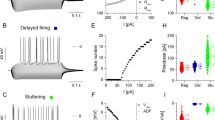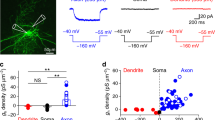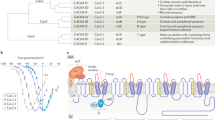Abstract
THE change in permeability produced at excitatory synapses by chemical transmitters tends to drive the membrane toward an equilibrium potential which is closer to zero potential than is the resting level. In the central neurones which have so far been examined1 the passive electrical properties of the extrasynaptic membrane have been shown to be relatively constant for small subthreshold depolarizations and for a wide range of hyperpolarizations. Consequently, hyperpolarizing currents, which move the membrane potential away from the equilibrium level, increase the amplitude of the excitatory post-synaptic potential (EPSP) (but see ref. 2), while depolarizing currents, which bring the membrane potential toward the equilibrium-level, decrease the amplitude of the EPSP.
This is a preview of subscription content, access via your institution
Access options
Subscribe to this journal
Receive 51 print issues and online access
$199.00 per year
only $3.90 per issue
Buy this article
- Purchase on Springer Link
- Instant access to full article PDF
Prices may be subject to local taxes which are calculated during checkout
Similar content being viewed by others
References
Eccles, J. C., Ergebn. Physiol., 51, 300 (1961).
Coomb, J. S., Eccles, J. C., and Fatt, P., J. Physiol. (London), 130, 374 (1955).
Tauc, L., and Gerschenfeld, H. M., Nature, 192, 366 (1961).
Furshpan, E. S., and Potter, D. D., J. Physiol. (London), 145, 289 (1959).
Grundfest, H., Ann. N.Y. Acad. Sci., 94, 405 (1961).
Araki, T., and Terzuolo, C. A., J. Neurophysiol., 25, 772 (1962).
Frank, K., and Tauc, L., Fed. Proc., 22 (1963).
Hagiwara, S., in Electrical Activity of Single Cells (Igakushoin, Hongo, Tokyo, 1960).
Fatt, P., and Katz, B., J. Physiol. (London), 115, 320 (1951).
Freygang, W. H., and Adrian, R. H., in Biophysics of Physiological and Pharmacological Actions, 245 (1961).
Katz, B., Arch. Sci. Physiol., 3, 285 (1949).
Nakajima, S., Iwasaki, S., and Obata, X., J. Gen. Physiol., 46, 97 (1962).
Rueben, J. P., and Gainer, H., Nature, 193, 142 (1962).
Tauc, L., Bruner, J., and Hughes, G. M. (unpublished observations).
Tauc, L., J. Gen. Physiol., 46, 1077 (1962).
Cole, K. S., and Curtis, H. J., J. Gen. Physiol., 24, 561 (1941).
Author information
Authors and Affiliations
Rights and permissions
About this article
Cite this article
TAUC, L., KANDEL, E. An Anomalous form of Rectification in a Molluscan Central Neurone. Nature 202, 1339–1341 (1964). https://doi.org/10.1038/2021339a0
Issue Date:
DOI: https://doi.org/10.1038/2021339a0
This article is cited by
-
A Cl− conductance activated by hyperpolarization in Aplysia neurones
Nature (1982)
-
Akute Wirkungen von R�ntgenstrahlen auf Membranpotential und -widerstand von Schneckenneuronen
Radiation and Environmental Biophysics (1974)
-
Stationäre Strom-Spannungskennlinien von Blutegel-Ganglien-Zellen
Pflügers Archiv - European Journal of Physiology (1965)
Comments
By submitting a comment you agree to abide by our Terms and Community Guidelines. If you find something abusive or that does not comply with our terms or guidelines please flag it as inappropriate.



